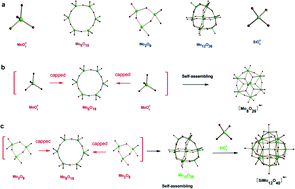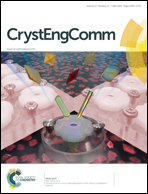Synthesis, structures, and theoretical investigation of three polyoxomolybdate-based compounds: self-assembly, fragment analysis, orbital interaction, and formation mechanism†
Abstract
Three Mo8- and Mo12-based polyoxoanion compounds (1–3), containing [Mo8O26]4− and [(SiO4)(Mo12O36)]4− anions, were successfully synthesized by a one-pot hydrothermal method, and structurally characterized by an X-ray crystallographic method. 1, [Cu(L′)4]2[Mo8O26] (L′ = 1-methyl-imidazole), contained rarely observed Mo8-based oblate shell [Mo8O26]4− polyoxoanion, 2, [L′′H]4[SiMo12O40]·5[L′′]·5H2O (L′′ = benzotriazole), and 3, [L′′H]4[SiMo12O40]·2H2O, contained Mo12-based spherical shell α-Keggin [(SiO4)(Mo12O36)]4− polyoxoanions. Interestingly, SiO44− fragment is disordered in 2 but is ordered in 3. The observation that 1–3 have different polyoxoanion structures but crystallize in order in the same solution system is rare for POM synthetic chemistry, and is of interest for understanding the formation mechanism and self-assembly process of Mo-based polyoxoanions. Fragment analysis based on the clathrate structural model, i.e. [Mo8O26]4− anion modeled as [MoO4]24−@Mo6O18, and [(SiO4)(Mo12O36)]4− anion modeled as [SiO4]4−@[Mo12O36] and/or [SiO4]4−@[Mo3O9]2@[Mo6O18], and orbital interaction analysis based on extended Hückel theory calculation were employed successfully to account for the formation mechanism and self-assembly process of fragments and two Mo-based polyoxoanions in 1–3. The calculated large charge transfer and/or high electronic polarization between fragments provide electronic structural information on structural stability and help to interpret the fragment–fragment self-assembly process.


 Please wait while we load your content...
Please wait while we load your content...